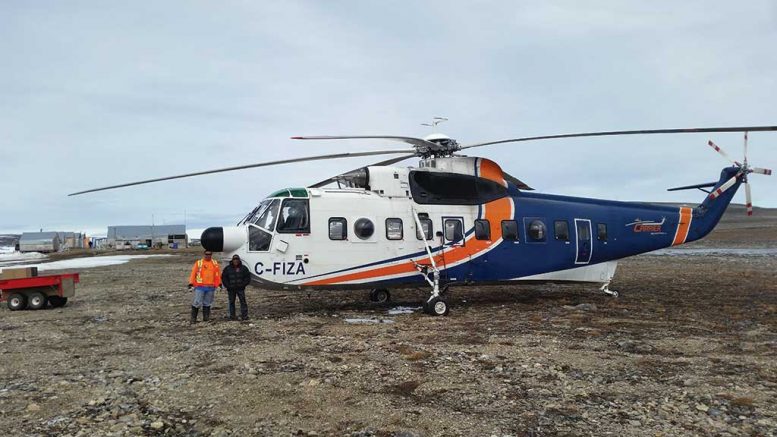A resource update has brought the combined inferred resource of just two of 74 known kimberlites to 22 million carats at Peregrine Diamonds’ (TSX: PGD) Chidliak project on Baffin Island.
“This result absolutely has positioned Chidliak in the Canadian development context as the next cab off the rank,” Peregrine’s president and CEO, Tom Peregoodoff, tells The Northern Miner in an interview from Vancouver. “It really does set Chidliak apart from the other advanced exploration and development projects in Canada, and likely even globally.”
The junior diamond exploration company increased the inferred resource of its high-grade No. 6 kimberlite to 17.96 million carats in 7.46 million tonnes, at an average grade of 2.41 carats per tonne.
The resource, which extends 525 metres below surface, contains a high-grade portion of 1.29 million tonnes at an average grade of 4.49 carats per tonne for 5.80 million carats.
When combined with the 4.23 million carats in 4.99 million inferred tonnes already on the books for its No. 7 kimberlite, Peregrine has a lot to be pleased about, Peregoodoff says, including the greater depth of the No. 6 resource.
“We’ve almost doubled the depth extent of the resource,” he says. “We’ve also confirmed that there is geological continuity … it’s a simple pipe, from a geological context … the 4.49-carat-per-tonne, high-grade core extends down, and we’ve defined it to a depth of 470 metres.”
The No. 6 kimberlite has two basic geologic units, Peregoodoff says — KIM-L and KIM-C — and while the grade within the geological units varies, the size and frequency of distribution do not, which means that each unit may have a different grade, but the coarse diamond distribution will be consistent.

Geologist David Ritcey surveying at the Chidliak property for Peregrine Diamonds in 2017. Credit: Peregrine Diamonds.
The company is incorporating the new resource into a revised preliminary economic assessment (PEA). The first PEA — finished in July 2016 — envisaged a 10-year mine life at an annual average production rate of 1.2 million carats, with a $471-million, after-tax net present value, 29.8% internal rate of return and a two-year capital payback.
The revised PEA should be finished by June.
If Chidliak goes into production, it likely would be a combination of open-pit and underground, similar to the Ekati and Renard diamond mines, which started as open pits and then moved underground.
“At nearly 4.5 carats per tonne, that’s very high-value rock, and I can’t see any reason why that material will not support an underground development,” Peregoodoff says.
While the mining executive says it’s hard to compare diamond projects — largely because their value per tonne is a combination of grade and average value per carat — he can draw comparisons about grade.
“No. 6’s 4.49 carats per tonne compares very well with high-grade material that was initially discovered at Diavik and put into production,” he says. “Even the other material that comprises the majority of the [No. 6] pipe — at 2 carats per tonne plus — compares extremely well with either operation at Ekati and Diavik, and is better than most of the grades reported at Stornoway and Gaucho Kué.”

A large-diameter rig on site in 2015 during the CH-7 kimberlite bulk sample at Peregrine Diamonds’ Chidliak diamond project on Baffin Island in Nunavut. Credit: Peregrine Diamonds.
He also notes that No. 6 remains open for expansion to depth, and that the company has already found 1.09 to 2.35 million tonnes in part of the kimberlite pipe at depths between 300 and 590 metres below surface.

A helicopter moving drilling equipment on Peregrine Driamonds’ Chidiak property. Credit: Peregrine Diamonds.
In addition, results from No. 7 have room for improvement. The company has been open about some of the challenges it has had there with its large-diameter drill program.
“We did break a lot of nice stones, and that has two impacts. It means the reported grade is probably lower than it could be and the value — the average stone value — is lower than it could be because some of the stones valued were broken, cracked or chipped, and that lowered the price, so there are real opportunities to increase the resource at No. 7.”
The company also sees exploration potential at the No. 1 and No. 44 kimberlites, among others.
“No. 1 is the first pipe we ever discovered and a mini-bulk sample from surface produced a 2-carat macro stone, and it was a nice 2-carat stone, so there’s lots of potential from No. 1 to move into the resource category,” Peregoodoff says, adding that No. 44 is a target for more exploration.
“No. 44 is something else we’ve always intended to bulk sample, and I think we’ll start looking at opportunities to do that, as well,” he says.
“This is going to be a big year for Chidliak. The PEA is going to be an important part of that and there are other matters going on that we can speak publicly about once finalized, but I do think 2018 is going to be a big year.”
As for Peregrine’s 14¢ stock price, which has traded over the last 52 weeks between 11¢ per share (August 2017) and 23¢ per share (May 2017), Peregoodoff says the company will reward patient shareholders.
“Right now, I believe we’re undervalued in the market, and I think that obviously does raise concerns about us being a potential takeover target,” he says. “But I’ve got very strong shareholders who understand the market may not be reflecting the value yet, but it eventually will.”


i missed out on ekati and diavic. i have been sitting on peregrine for several years.
i have always believed that sooner or later, i would be well rewarded and i believe that is about to happen.